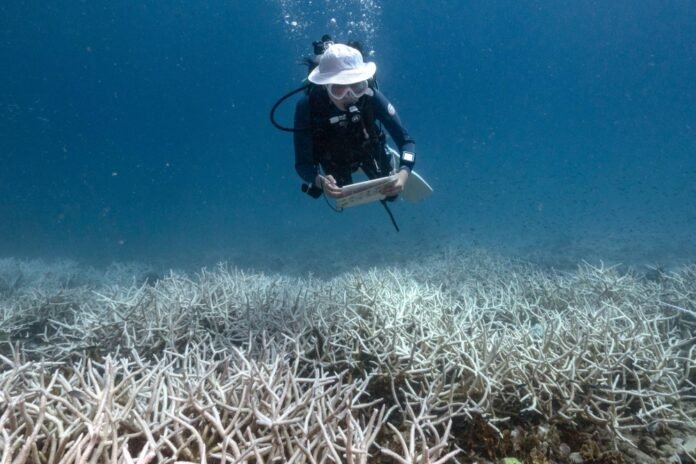A diver glides over an expanse of stark white coral branches, recording the fish darting between the ghostly arms that extend from the seabed off the Thai island of Koh Tao.
Nannalin Pornprasertsom is one of a growing number of divers taking on conservation and citizen science as coral reefs experience their fourth global bleaching event.
After a two-week course on Koh Tao, the 14-year-old can identify coral types, carry out reef restoration and assist scientific research into coral health by recording the color and tone of outcroppings at dive sites.
“It’s just something I can do that will have a good impact on the environment,” Nannalin, who has been diving since she was 12, said after a series of dives.
“I want to help the reef.”
And she’s not the only one.
According to the Professional Association of Diving Instructors, better known as PADI, one of the world’s leading diver training organizations, the number of conservation certifications worldwide increased by more than 6% from 2021 to 2023.
This year it is launching a major shark and ray census, using its network of divers to collect data that will shape conservation policy.
On Koh Tao, Black Turtle Dive offers courses on everything from how to properly “debris dive” – collecting marine plastic or stranded fishing nets – to coral restoration techniques.
“There’s a greater awareness,” says Steve Minks, a certified conservation instructor with Black Turtle.
“There is a lot of bleaching going on and a lot of concern about the marine environment.”
Coral polyps are animals that rely on algae for most of their food. These algae usually also give the reef its color.
But when the sea is too warm, the polyps expel the algae.
The reef turns white and the coral begins to starve.
Since early 2023, more than 60 countries have recorded coral bleaching, threatening reefs that are critical to ocean biodiversity and support fishing and tourism worldwide.
The death spiral is ubiquitous in the waters of the Gulf of Thailand around Koh Tao.
Most affected are branching species that grow quickly but are also less resilient.
If the water temperature drops, they have a chance of recovery.
But for now, their spectral stalks are visible even from the surface, shimmering through the aquamarine water.
“I wasn’t ready for so much bleaching, it has quite an impact,” admits instructor Sandra Rubio.
The 28-year-old says bleaching and other marine degradation are driving divers to take her conservation courses.
“People want to start learning because they see these kinds of changes,” she said.
“And even if they don’t really understand why, they know it’s not right.”
She shows students how to identify species, including soft coral.
Wave at it, she explains, miming a hand in the water, and wait to see if it “waves back.”
The skills taught at Black Turtle and other dive shops are not just theoretical.
Artificial coral reefs are spread across Koh Tao and are actively restoring marine habitats.
And Nannalin’s data on coral health is part of Coral Watch – a global citizen science project that has produced numerous research papers.
“What we do is collect data for scientists so that they can actually collaborate with governments and authorities,” Minks explains.
On a sunny afternoon on Koh Tao, a boat takes a starfish-shaped reinforcement structure designed by schoolchildren out to sea, where it will become Global Reef’s latest coral restoration project.
Since its founding two years ago, Global Reef has transplanted about 2,000 coral colonies, with a survival rate of about 75%, said Gavin Miller, director of the group’s science program.
“It may not actually save coral reefs globally… but what it does do is have a very, very big impact locally,” he said.
“Snappers are coming back. We have puffer fish here.”
Global Reef also hosts interns who train artificial intelligence programs to identify fish in 360-degree videos for reef health studies, and regularly collaborates with the diving school next door.
And they study the surprising resilience of local coral against persistently high temperatures.
“These can be like refuges for coral,” Miller explains.
This year’s bleaching has left many water sports enthusiasts despondent, but for conservation divers on Koh Tao it is also a call to arms.
“In previous generations we didn’t have the research and education that we have now,” says Nannalin.
“I think people my age should make the best of it and do their best to undo the things that have already been done.”
The work also helps Rubio balance the sadness she feels about the changes underwater.
“It’s not like we’re going to change things overnight, but we’re doing our best and that’s the best feeling,” she said.
“I work every day to do something good for the environment and for the reef I love.”



